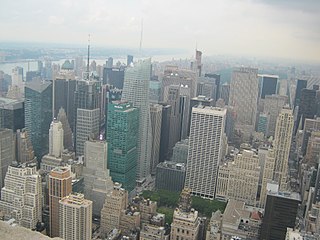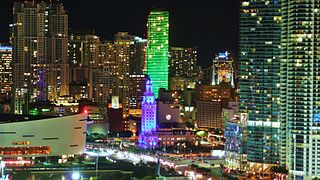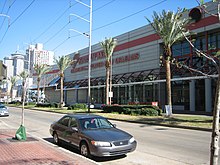
New Orleans is a consolidated city-parish located along the Mississippi River in the southeastern region of the U.S. state of Louisiana. With a population of 383,997 according to the 2020 U.S. census, it is the most populous city in Louisiana, third most populous city in the Deep South, and the twelfth-most populous city in the southeastern United States. Serving as a major port, New Orleans is considered an economic and commercial hub for the broader Gulf Coast region of the United States. New Orleans is also a region of French Louisiana, along with the Cajun Country.

Interstate 12 (I-12) is an Interstate Highway located entirely within the US state of Louisiana. It spans a total of 85.59 miles (137.74 km) in an east–west direction from I-10 in Baton Rouge to an interchange with both I-10 and I-59 in Slidell. Along the way, it passes through the city of Hammond, where it intersects I-55 and US Route 51 (US 51). It also serves the cities of Ponchatoula and Denham Springs, as well as the St. Tammany Parish cities of Covington and Mandeville. Skirting the northern shore of Lake Pontchartrain, I-12 serves as both a northern bypass of the New Orleans metropolitan area and an alternate route for I-10, which serves the city of New Orleans itself.

A central business district (CBD) is the commercial and business centre of a city. It contains commercial space and offices, and in larger cities will often be described as a financial district. Geographically, it often coincides with the "city centre" or "downtown". However, these concepts are not necessarily synonymous: many cities have a central business district located away from its commercial and or cultural center and or downtown/city center, and there may be multiple CBDs within a single urban area. The CBD will often be characterized by a high degree of accessibility as well as a large variety and concentration of specialised goods and services compared to other parts of the city. For instance, Midtown Manhattan, New York City, is the largest central business district in the city and in the world. London's city center is usually regarded as encompassing the significantly smaller and historic City of London and the medieval City of Westminster, while the City of London and the transformed Docklands area containing Canary Wharf are regarded as their two respective CBDs. In Chicago, Illinois, the Chicago Loop is the second-largest central business district in the United States. It is also referred to as the core of the city's downtown. Mexico City also has its own historic city center, the colonial-era "Centro Histórico", along with two CBDs: the mid-late 20th century Paseo de la Reforma – Polanco, and the new Santa Fe, respectively. Moscow and Russia's largest central business district is the Moscow International Business Center.

Downtown is a term primarily used in North America by English speakers to refer to a city's sometimes commercial, cultural and often the historical, political, and geographic heart. It is often synonymous with its central business district (CBD). Downtowns typically contain a small percentage of a city's employment. In some metropolitan areas it is marked by a cluster of tall buildings, cultural institutions and the convergence of rail transit and bus lines. In British English, the term "city centre" is most often used instead.

Downtown Los Angeles (DTLA) contains the central business district of Los Angeles. In addition, it contains a diverse residential area of some 85,000 people, and covers 5.84 sq mi (15.1 km2). A 2013 study found that the district is home to over 500,000 jobs. It is also part of Central Los Angeles.

Downtown is the central business district of Seattle, Washington. It is fairly compact compared with other city centers on the U.S. West Coast due to its geographical situation, being hemmed in on the north and east by hills, on the west by Elliott Bay, and on the south by reclaimed land that was once tidal flats. It is bounded on the north by Denny Way, beyond which are Lower Queen Anne, Seattle Center, and South Lake Union; on the east by Interstate 5, beyond which is Capitol Hill to the northeast and Central District to the east; on the south by S Dearborn Street, beyond which is Sodo; and on the west by Elliott Bay, a part of Puget Sound.

Canal Street is a major thoroughfare in the city of New Orleans. Forming the upriver boundary of the city's oldest neighborhood, the French Quarter or Vieux Carré, it served historically as the dividing line between the colonial-era (18th-century) city and the newer American Sector, today's Central Business District.

The Central Business District (CBD) is a neighborhood of the city of New Orleans, Louisiana, United States.

Downtown Newark is the central business district of Newark in Essex County, in the U.S. state of New Jersey.

Downtown Las Vegas is the central business district and historic center of Las Vegas, Nevada, United States. It is the original townsite, and the Downtown gaming area was the primary gambling district of Las Vegas prior to the Strip. As the urban core of the Las Vegas Valley, it features a variety of hotel and business highrises, cultural centers, historical buildings and government institutions, as well as residential and retail developments. Downtown is located in the center of the Las Vegas Valley and just north of the Las Vegas Strip, centered on Fremont Street, the Fremont Street Experience and Fremont East. The city defines the area as bounded by I-15 on the west, Washington Avenue on the north, Maryland Parkway on the east and Sahara Avenue on the south.

Downtown Memphis, Tennessee is the central business district of Memphis, Tennessee and is located along the Mississippi River between Interstate 40 to the north, Interstate 55 to the south and I-240 to the east, where it abuts Midtown Memphis.

In New Orleans, Louisiana, United States, downtown has historically referred to neighborhoods along the Mississippi River, downriver from Canal Street – including the French Quarter, Tremé, Faubourg Marigny, Bywater, the 9th Ward, and other neighborhoods. Contrary to the common usage of the term downtown in other cities, this historic application of the term excluded the New Orleans Central Business District. The term continues to be employed as it has been historically, although many younger people and migrants from other parts of the country will use "downtown" as it is used elsewhere; that is, to mean the Central Business District/Warehouse District area.

Sidney John Barthelemy is a former American political figure. The second African American to hold the New Orleans mayoral chair, he was a member of the Louisiana State Senate from 1974 to 1978 and a member at-large of the New Orleans City Council from 1978 to 1986. He served as mayor of New Orleans from 1986 to 1994. He is a member of the Democratic Party.
The city planning commission for New Orleans divided the city into 13 planning districts and 73 distinct neighborhoods in 1980. Although initially in the study 68 neighborhoods were designated, and later increased by the City Planning Commission to 76 in October 2001 based in census data, most planners, neighborhood associations, researchers, and journalists have since widely adopted the 73 as the number and can even trace the number back to the early 1900s. While most of these assigned boundaries match with traditional local designations, some others differ from common traditional use. This is a result of the city planning commission's wish to divide the city into sections for governmental planning and zoning purposes without crossing United States census tract boundaries. While most of the listed names have been in common use by New Orleanians for generations, some designated names are rarely heard outside the planning commission's usage.

U.S. Highway 90 Business is a business route of U.S. Highway 90 located in and near New Orleans, Louisiana. It runs 14.25 miles (22.93 km) in a general east–west direction from US 90 in Avondale to a junction with Interstate 10 (I-10) and US 90 in the New Orleans Central Business District.

Downtown Miami is the urban city center of Miami, Florida, United States. The city's greater downtown region consists of the Central Business District, Brickell, the Historic District, Government Center, the Arts & Entertainment District, and Park West. It is divided by the Miami River and is bordered by Midtown Miami's Edgewater, and Wynwood sections to its north, Biscayne Bay to its east, the Health District and Overtown to its west, and Coconut Grove to its south.

Troy Anthony Carter is an American politician serving as the U.S. representative for Louisiana's 2nd congressional district since 2021. He was previously a member of the Louisiana State Senate for the 7th district. A member of the Democratic Party, Carter also previously served on the New Orleans City Council and as a member of the Louisiana House of Representatives.

The city of New Orleans was once home to one of the largest Chinatowns in the Southern United States. It existed from the 1880s until its destruction by WPA re-development in 1937, and it was located at the end of Tulane Avenue, at the 1100-block near Elk Place and South Rampart Street, south of the Tulane stop on the modern North Rampart streetcar line.

The Central Business District (CBD) of Miami is the historic central business district and city center of what has become Greater Downtown Miami in Miami, Florida. Over 92,000 people work in Miami's Central Business District.


















